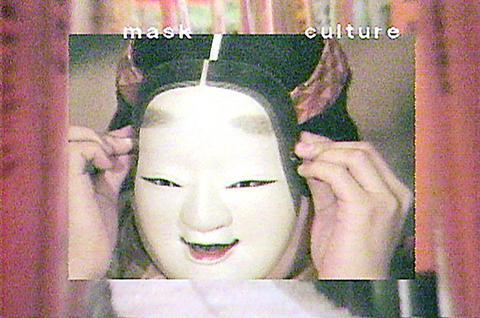It's odd to have a Gary Hill exhibition come to town when this pioneer in video art is finally starting to look old and low tech and deconstruction is going out of style. But the Museum of Contemporary Art, Taipei, has filled its upstair galleries with a condensed greatest hits of this middle-aged contemporary master.
The show, Unfolding Visions: Gary Hill Selected Works 1976 to 2003, comes off as technically very important, like required reading on a syllabus. Because the reigning critical consensus says: "How can you talk about video at all without talking about Gary Hill?" And MOCA makes this point by offering it as a complement and precursor to the brand new, computer generated videos and network game art of Chinese artist Feng Mengbo (

PHOTO COURTESY MOCA
But the show is still difficult. Maybe it's because it's hard to see the novelty in video techniques that were experimental in the early 1970s. Maybe it's because a TV playing in the middle of a gallery looks clumsy now. Maybe it's because many of the concepts Hill helped introduce into visual art -- the labyrinthine nature of language and texts -- have since been explored to death.

PHOTO COURTESY MOCA
Born in 1951, Hill was of contemporary art's first generation. He switched from welded steel sculpture to video in the early 1970s and has almost come to define the "video artist," even though he's said he doesn't relish the designation. Only Nam Jun Paik, the father of video art, ranks above him.
Hill's early works were all "single channel" videos of only a few minutes in length. They explored how video images could be distorted and changed through electronical processing [in the galleries they appear on back to back TVs as Selected Works I and Selected Works II].

PHOTO COURTESY MOCA
By the late 1970s, Hill began adding sound to his creations, and the thematic focus moved away from image and towards language. In Primary Colors, a work of 1981 to 1983, Hill makes a video with two inset rectangular screens, each of which corresponds to a voice. When one voice speaks, its screen changes, sometimes cutting to a new image with each new word, sometimes cutting with each new syllable (MTV began perfecting the same technique of matching visual cuts with beats at around the same time). The two voices engage in a dialogue that makes sense for perhaps a few exchanges at a time, but inevitably degenerates into nonsense. Images meanwhile offer similarly meaningless visual puns: a mention of objectivity turns the insets to black and white; the phrase "hang in there" is matched by a shot of a dangling cow's udder.
Hill was fascinated with an odd characteristic of language, how most is actually is nonsense that fails to communicate. As he pushed this idea further, he interrogated and subverted language more vigorously. In the 1979 video Soundings, he films stereo speakers reverbrating with fatalistic statements about how they are about to be silenced: one is submerged, one buried, one pierced and one burned.
By 1995 he had created the installation Bind, the piece that greets visitors to the exhibition and establishes the theme of smothered and helpless texts. The work consists of an open book bound with steel cables to a small television set so that it is covering the screen. The open pages also face the screen so they cannot be read. Around the edges of the book however, you can see the TV flashing, and you can hear Hill's voice reading passages which are predictably difficult to follow, if, in fact, they can be understood at all.
But perhaps the book itself sums up the point. It's called The Humiliation of the Text, and its back jacket blurb reads: "Jacques Ellul for the first time intertwines sociological analysis with theological discussion in this provocative examination of how reality (which is visual) has superseded truth (which is verbal) in modern times." By this time Hill had pursued language deeper and deeper into its labyrinth, and he'd finally come to the conclusion that such an investigation will only get you lost.
This statement is made most elequently in one of the most acclaimed works of his career, 1992's installation Tall Ships. In it Hill disposes with language altogether, bringing viewers into a 30m-long, dark corridor, where they encounter a dozen spectral figures at regular intervals and total silence. The figures, people of all ages and walks of life, are black and white video projections that seem like holograms. Slowly, like the ships sailing in and out of the Pacific northwest fog that inspired Hill, they advance towards the viewer and then retreat, coming to the absolute verge of communicating through silent gestures and the absolute admission that between every two individuals there is an unbridgeable gap.
Hill was to perform Black Performance at the museum on May 2. But his visit was postponed due to SARS. If local conditions improve, Hill will come to give the performance on June 21. Unfolding Visions is on display through Aug. 24. MOCA Taipei is located at 39, Chang-an W Rd, Taipei (

This month the government ordered a one-year block of Xiaohongshu (小紅書) or Rednote, a Chinese social media platform with more than 3 million users in Taiwan. The government pointed to widespread fraud activity on the platform, along with cybersecurity failures. Officials said that they had reached out to the company and asked it to change. However, they received no response. The pro-China parties, the Chinese Nationalist Party (KMT) and Taiwan People’s Party (TPP), immediately swung into action, denouncing the ban as an attack on free speech. This “free speech” claim was then echoed by the People’s Republic of China (PRC),

Exceptions to the rule are sometimes revealing. For a brief few years, there was an emerging ideological split between the Democratic Progressive Party (DPP) and Chinese Nationalist Party (KMT) that appeared to be pushing the DPP in a direction that would be considered more liberal, and the KMT more conservative. In the previous column, “The KMT-DPP’s bureaucrat-led developmental state” (Dec. 11, page 12), we examined how Taiwan’s democratic system developed, and how both the two main parties largely accepted a similar consensus on how Taiwan should be run domestically and did not split along the left-right lines more familiar in

As I finally slid into the warm embrace of the hot, clifftop pool, it was a serene moment of reflection. The sound of the river reflected off the cave walls, the white of our camping lights reflected off the dark, shimmering surface of the water, and I reflected on how fortunate I was to be here. After all, the beautiful walk through narrow canyons that had brought us here had been inaccessible for five years — and will be again soon. The day had started at the Huisun Forest Area (惠蓀林場), at the end of Nantou County Route 80, north and east

Specialty sandwiches loaded with the contents of an entire charcuterie board, overflowing with sauces, creams and all manner of creative add-ons, is perhaps one of the biggest global food trends of this year. From London to New York, lines form down the block for mortadella, burrata, pistachio and more stuffed between slices of fresh sourdough, rye or focaccia. To try the trend in Taipei, Munchies Mafia is for sure the spot — could this be the best sandwich in town? Carlos from Spain and Sergio from Mexico opened this spot just seven months ago. The two met working in the